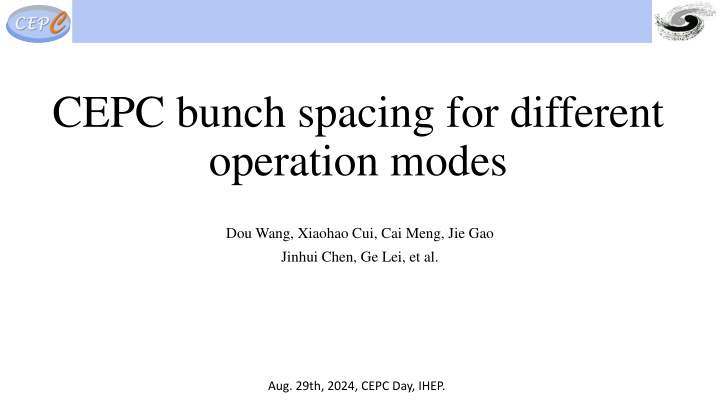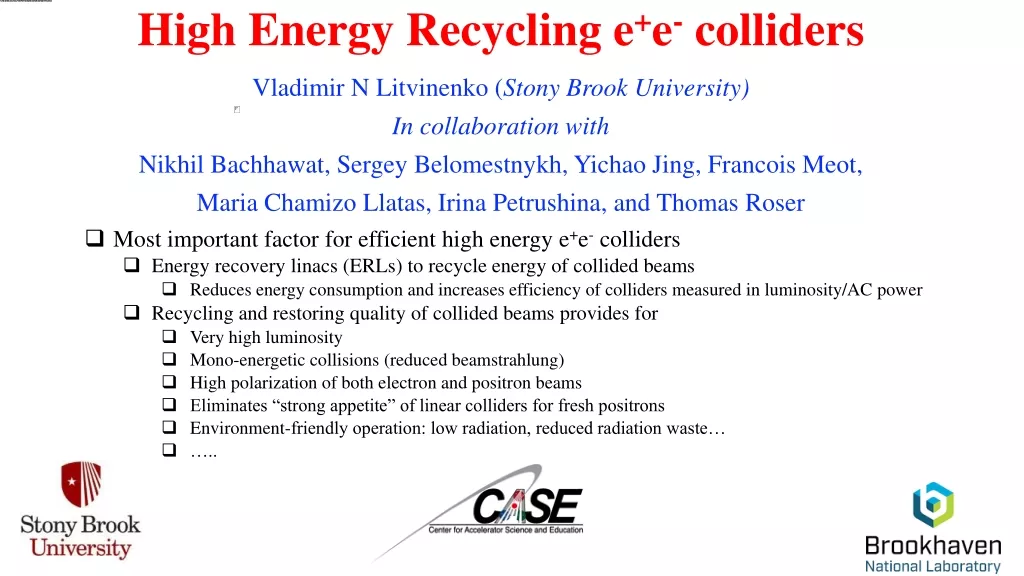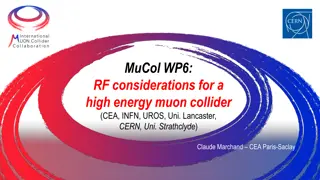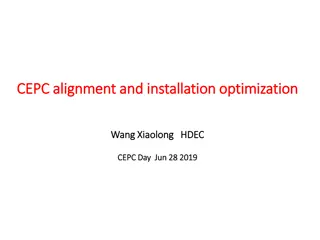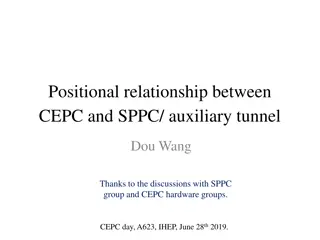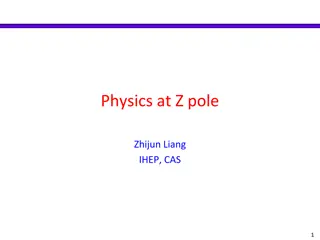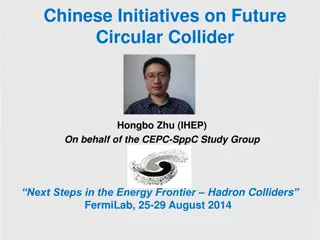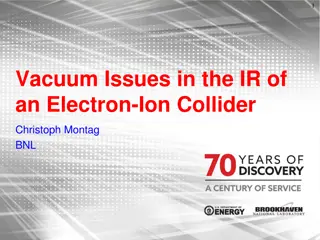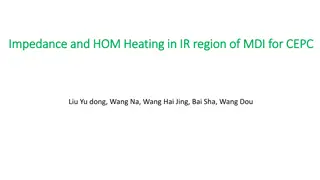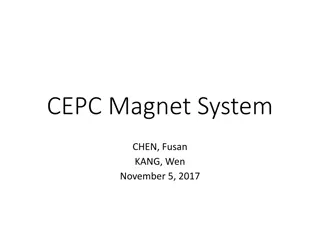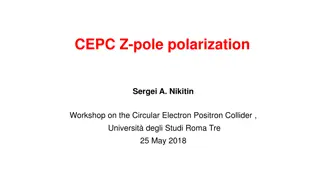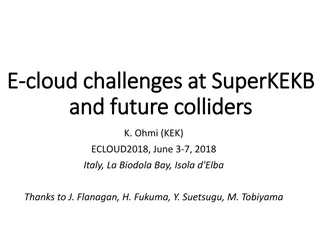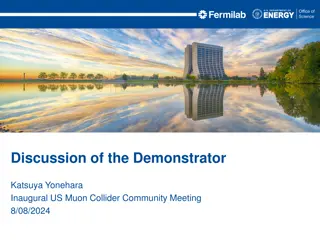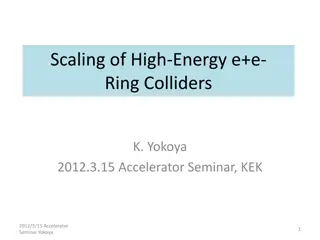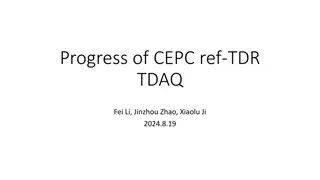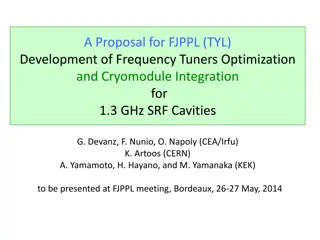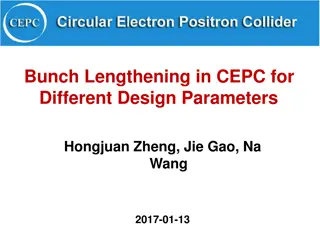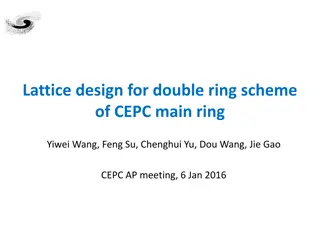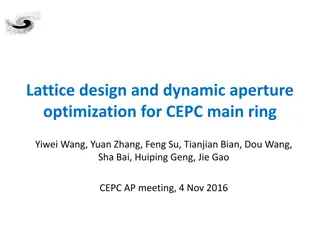CEPC Bunch Spacing and Frequency Requirements for High-Energy Collider Operations
The CEPC (Circular Electron Positron Collider) has specific requirements for bunch spacing and frequency in different operation modes to optimize performance. With detailed considerations for injection/extraction chain, bunch spacing from detector J.C. Wang, and frequency choices, the CEPC aims to seamlessly transition between energy modes without hardware changes. The collaboration between accelerator and detector technologies ensures efficient operation and maintains synchronization for beam experiments.
Download Presentation

Please find below an Image/Link to download the presentation.
The content on the website is provided AS IS for your information and personal use only. It may not be sold, licensed, or shared on other websites without obtaining consent from the author.If you encounter any issues during the download, it is possible that the publisher has removed the file from their server.
You are allowed to download the files provided on this website for personal or commercial use, subject to the condition that they are used lawfully. All files are the property of their respective owners.
The content on the website is provided AS IS for your information and personal use only. It may not be sold, licensed, or shared on other websites without obtaining consent from the author.
E N D
Presentation Transcript
CEPC bunch spacing for different operation modes Dou Wang, Xiaohao Cui, Cai Meng, Jie Gao Jinhui Chen, Ge Lei, et al. Aug. 29th, 2024, CEPC Day, IHEP.
CEPC injection/extraction chain Requirements in collider ring (30MW) tt H W Z Energy (GeV) 180 120 80 45.5 Beam lifetime (min) 30 18 40 80 Bunch number 35 268 1297 11934 Bunch population ( 1011) 2.0 1.3 1.4 1.4 Interval for top up* (s) 64 36 155 153 *Beam current in collider dacays by 3%. (to Dump) Both top up injection and full injection from empty for the collider ring needs to be fulfilled. 10 injection/extraction systems Injection & extraction hardware should be compatible for four energy modes. 2
CEPC Bunch Spacing Requirement from detector J. C. Wang There are possible 3564 bunch positions in the circumference of an LHC ring, with 25 ns bunch spacing. Only ~80% (e.g. 2808) are filled in the standard filling scheme The LHC experiments operate at 40 MHz (1/25ns), synchronized with the beam. Most electronic components and detector technologies developed at CERN aim to serve the LHC experiments. Thus they are optimized to a base frequency of 40 MHz. To avoid re-invention or re-optimization and allow maximal use of commonly available components, CEPC should set a similar base frequency, providing that the impact to the performance is under control. The smallest clock period for CEPC accelerator is 7.69 ns (130 MHz) according to the accelerator side. For the Z mode, the bunch spacing was initially 15.4 ns (50MW). It was adjusted to 23.1 ns after a special joint accelerator and detector meeting in September 2021. Thus the CEPC detector and electronics should be optimized to 43.3 MHz. The CERN electronic components, e.g. GBTx / lpGBT, work properly with small adjustments if necessary, according to CERN experts. CEPC plans to operate in H, Z, W+W-, and ttbar modes with different bunch spacing, and could switch between different modes without hardware change. Thus the bunch spacing of all modes need to be integer 23.1 ns. A 43.3 MHz clock should be provided by the accelerator to the experiments, synchronized with the bunches. The detectors lock to this beam clock with PLL/DLL and sample signal at pre-fixed optimal phases. 3
CEPC frequency choice f (MHz) SHB1 SHB2 Linac_S DR Linac_C Booster Collider Baseline (thermal cathode gun) Alternative (RF gun) RF gun 158.89 476.76 2860 650 5720 1300 650 CEPC 2860 650 5720 1300 650 FCC 2800 400 5600 400 400 CEPC: greatest common divisor=130 MHz Min bunch spacing @ rings: 7.6923ns Bunch spacing @ Z: 7.6923 3=23.0769 ns FCC: greatest common divisor=400 MHz Min bunch spacing @ rings: 2.5 ns 4
Bunch structure in Linac and DR Bunch structure at Z is shown. Other modes are similar and straightforward. Room temp. copper acc. structure for the Linac Single bunch scheme for tt, H and W Linac repetition rate: 100Hz Double bunch scheme at Z pole 69ns 69ns 69ns 5
Bunch structure in Booster tt H 268 bunches 35 bunches Train structure @Z 51 train W Z 78 bunch/train 1297 bunches 3978 bunches 6
Bunch structure in Collider tt H 268 bunches 35 bunches Train structure @Z 153 train W Z 78 bunch/train 1297 bunches 11934 bunches 7
Bunch spacing for different operation modes SR 30MW W 30 1297 Higgs 30 268 Z ? ? 30 35 30 10 SR power per beam (MW) Bunch number 11934 3978 23.1( 1) 69.2( 3) 576.9 ( 25) 4523.1( 196) Bunch spacing (ns) 253.8( 11) 17 115 17 38 54 5.0 53 0.5 Train gap (%) Luminosity per IP (1034cm 2s 1) 1 16 SR 50MW W Higgs Z ? ? 50 SR power per beam (MW) Bunch number 446 346.2 ( 15) 54 8.3 13104 23.1 ( 1) 9 192 58 2162 138.5 ( 6) 10 26.7 2700.0 ( 117) 53 0.8 Bunch spacing (ns) Train gap (%) Luminosity per IP (1034cm 2s 1) 8
Summary The timing structure of CEPC for four energy modes and different injection scheme have been designed with the consideration of clock system, RF frequency choice, bunch pattern, injection hardware, etc. Both top up injection and full injection from empty for the collider ring can be fulfilled. The minimum bunch separation is determined by the frequency compatibility among different accelerator parts which is 7.6923ns. -- Min bunch spacing @Z = 7.6923 3=23.0769 ns -- Bunch spacing for tt, Higgs, and W is an integer multiple of 23.0769 ns Accelerator people are willing to learn more detail of the timing issues of the detector. The discussion about timing and filling scheme for CEPC is continuous. 9
Reference 1. Dou Wang, Xiaohao Cui, et al., Problems and considerations about the injection philosophy and timing structure for CEPC , International Journal of Modern Physics A (2022) 2246006 2. Dou Wang, Problems and considerations about the timing & bunch pattern , CEPC day, Aug. 2021 3. Cai Meng, Timing and bunch pattern compatibility study for multi RF frequencies , CEPC day, Jan. 2022 4. Cai Meng, CEPC Linac injector design status , CEPC2022 Workshop, Oct. 2022 5. Xiaohao Cui, CEPC Transport lines and Timing , CEPC2023 Workshop, Oct. 2023 10
Back up 12
CEPC baseline parameters in TDR W Higgs Z ? ? Number of IPs Circumference (km) SR power per beam (MW) Half crossing angle at IP (mrad) Bending radius (km) Energy (GeV) Energy loss per turn (GeV) Damping time x/ y/ z (ms) Piwinski angle Bunch number 2 100.0 30 30 10 30 30 16.5 10.7 45.5 0.037 120 1.8 80 180 9.1 0.357 816/816/408 24.23 11934 23.1 (17% gap) 1.4 803.5 60 1.43 0.13/0.9 0.27/1.4 317/317 6/35 2.5/8.7 0.04/0.13 1.0/1.7 0.004/0.127 0.12 44.6/44.6/22.3 4.88 268 13.2/13.2/6.6 1.23 35 150/150/75 5.98 1297 3978 69.2 576.9 (54% gap) 4523.1 (53% gap) 253.8 (1% gap) Bunch spacing (ns) (17% gap) 1.3 16.7 90 0.71 0.3/1 0.64/1.3 445/445 14/36 2.3/4.1 0.10/0.17 1.6/2.2 0.015/0.11 2.2 2.0 3.3 90 0.71 1.04/2.7 1.4/4.7 445/445 39/113 2.2/2.9 0.15/0.20 2.0/2.6 0.071/0.1 10 Bunch population (1011) Beam current (mA) Phase advance of arc FODO ( ) Momentum compaction (10-5) Beta functions at IP x*/ y*(m/mm) Emittance x/ y(nm/pm) Betatron tune x/ y Beam size at IP x / y (um/nm) Bunch length (natural/total) (mm) Energy spread (natural/total) (%) Energy acceptance (DA/RF) (%) Beam-beam parameters x/ y RF voltage (GV) RF frequency (MHz) Longitudinal tune s Beam lifetime (Bhabha/beamstrahlung) (min) Beam lifetime requirement (min) Hourglass Factor Luminosity per IP (1034cm 2s 1) 1.35 84.1 60 1.43 0.21/1 0.87/1.7 317/317 13/42 2.5/4.9 0.07/0.14 1.2/2.5 0.012/0.113 0.7 267.8 650 0.035 90/2800 77 0.97 115 0.049 40/40 18 0.9 5.0 0.078 81/23 18 0.89 0.5 0.062 60/195 22 0.9 16 68 38 13
CEPC main parameters with 50 MW upgrade W Higgs Z ? ? 2 Number of IPs Circumference (km) SR power per beam (MW) Half crossing angle at IP (mrad) Bending radius (km) Energy (GeV) Energy loss per turn (GeV) Damping time x/ y/ z(ms) Piwinski angle Bunch number 100.0 50 16.5 10.7 45.5 0.037 120 1.8 80 180 9.1 0.357 816/816/408 29.52 13104 23.1 (9% gap) 2.14 1340.9 60 1.43 0.13/0.9 0.27/1.4 317/317 6/35 2.7/10.6 0.04/0.15 1.3/1.5 0.0045/0.13 0.1 150/150/75 5.98 2162 138.5 (10% gap) 1.35 140.2 60 1.43 0.21/1 0.87/1.7 317/317 13/42 2.5/4.9 0.07/0.14 1.2/2.5 0.012/0.113 0.7 44.6/44.6/22.3 4.88 446 346.2 (54% gap) 1.3 27.8 90 0.71 0.3/1 0.64/1.3 445/445 14/36 2.3/4.1 0.10/0.17 1.6/2.2 0.015/0.11 2.2 13.2/13.2/6.6 1.23 58 2700.0 (53% gap) 2.0 5.5 90 0.71 1.04/2.7 1.4/4.7 445/445 39/113 2.2/2.9 0.15/0.20 2.0/2.6 0.071/0.1 10 Bunch spacing (ns) Bunch population (1011) Beam current (mA) Phase advance of arc FODO ( ) Momentum compaction (10-5) Beta functions at IP x*/ y*(m/mm) Emittance x/ y(nm/pm) Betatron tune x/ y Beam size at IP x / y (um/nm) Bunch length (natural/total) (mm) Energy spread (natural/total) (%) Energy acceptance (DA/RF) (%) Beam-beam parameters x/ y RF voltage (GV) RF frequency (MHz) Longitudinal tune s Beam lifetime (Bhabha/beamstrahlung) (min) Beam lifetime requirement (min) Hourglass Factor Luminosity per IP (1034cm 2s 1) 650 0.032 90/930 81 0.97 192 0.049 40/40 20 0.9 8.3 0.078 81/23 18 0.89 0.8 0.062 60/195 25 0.9 26.7 14
Requirement of timing system Gang Li, Ge Lei Choose 130MHz as clock beat minimum time separation=7.69ns (FPGA clock &EVG/EVR transmission can be realized) Circumference of damping ring: (L*1000*109/(3*108))/(1000/650)=integer Length of transfer line between DR and Linac: N*150+75+104*2-8.3 109/(3*108))/(1000/2860)=integer 104m 101.65m Circumference of collider/booster: (L*1000*109/(3*108))/(1000/650)=integer Length of transfer line between booster and collider: (L*109/(3*108))/(1000/650)=integer 252m or 246m 15
Injection to booster Xiaohao Cui Injection into the booster is a simple on-axis injection with 1 kicker Bunches from the Linac will be in 100 Hz or 200 Hz Booster Ring TLinac Tbooster TLinac=N*Turns+Tbooster Changing TLinacslightly, we can fill the booster with any pattern we needed. 16
Injection to the collider Xiaohao Cui 1. Considering the robustness of the design, the injection of the main collider ring is conventional off-axis injection. (Maybe an on-axis injection is needed for Higgs) 2. For tt, Higgs and W energy, injection into the collider is bunch by bunch; and for Z energy, injection is train by train. Bunch by bunch Lamberson 26 mrad 66m 68m 60m 26m Train by train Kicker: 1000 Hz 1000 Hz The kickers rise up, stay there to inject a whole train into the collider, and fall down. This process repeated in 1000 Hz, to inject all bunches into the ring. The kickers rise up, inject one bunch into the collider, and fall down. This process repeated in 1000 Hz, to inject all bunches into the ring. 17
Timing consideration Cai Meng Frequency n=9, m1=11, m2=3, m3=6 Divide the common frequency to 14.44MHz, then multiply to the corresponding RF frequency Frequency multiplication to 2860MHz, 5720MHz by common frequency Frequency ???? ?cm Multiple Period 10.0 7.6923 69.23 69.23 6.2937 2.0979 0.3497 0.1748 1.5385 0.7692 1.5385 ???? ??? ????? ????? ?? ?1 ?? ?2 ?????? ??????2 ??? ???????? ????? Repetition frequency Common frequency Minimum Bunch frequency ????? _min Bunch frequency SHB1 RF frequency SHB2 RF frequency 100 130 14.44 14.44 158.89 476.76 2860 5720 650 1300 650 Hz MHz MHz MHz MHz MHz MHz MHz MHz MHz MHz / 9 1 1 11 33 198 396 45 90 45 ms ns ns ns ns ns ns ns ns ns ns ????? ?? ?1 ?? ?2 ?????? ??????2 ??? ???????? ????? LINAC RF frequency Damping ring RF frequency Booster RF frequency Ring RF frequency
Timing consideration Cai Meng High luminosity Z mode Comments Parameter Unit 30MW 50MW Baseline scheme RF gun scheme Baseline scheme RF gun scheme Repetition frequency Common frequency Linac common frequency Bunch frequency SHB1 RF frequency SHB2 RF frequency Hz MHz MHz MHz MHz MHz MHz MHz 100 130 14.44 14.44 158.89 476.67 130 43.33 / / 14.44 7.22 158.89 476.67 130 65.00 / / 2860.00 5720.00 650.00 1300.00 650.00 LINAC RF frequency Damping ring RF frequency MHz Booster RF frequency Ring RF frequency Bunch spacing @ Collider Bunch spacing @ Linac MHz MHz ns ns 23.08 69.23 23.08 23.08 15.38 138.46 15.38 15.38 pulse-by-pulse bunch-by-bunch 5(2k)+ [2,4] 5(2k+1) + [1,3] 2n pulse-by-pulse bunch-by-bunch 5(2k)+ [2,4] 5(2k+1) + [1,3] 2n Injection scheme bunch-by-bunch bunch-by-bunch 45*(2k) + [10, 20, 40] 45*(2k+1) + [5, 25] 6n 45*(2k) + [10, 20, 40] 45*(2k+1) + [5, 25] 18n Harmonic number k is an integer Bunch number per train n is an integer
Timing consideration Cai Meng High luminosity Z mode Baseline scheme Comments Parameter Unit RF gun scheme Repetition frequency Common frequency Linac common frequency Bunch frequency SHB1 RF frequency SHB2 RF frequency Hz MHz MHz MHz MHz MHz MHz MHz MHz MHz MHz ns ns 100 130 14.44 14.44 158.89 476.67 43.33 43.33 / / 2860.00 5720.00 650.00 1300.00 650.00 LINAC RF frequency Damping ring RF frequency Booster RF frequency Ring RF frequency Bunch spacing@Collider Bunch spacing@Linac 23.08 69.23 23.08 23.08 LLRF pulse-by-pulse bunch-by-bunch 5(2k)+ [2,4] 5(2k+1) + [1,3] 2n Injection scheme bunch-by-bunch 45*(2k) + [10, 20, 40] 45*(2k+1) + [5, 25] 6n k Harmonic number n Bunch number per train
On-axis injection scheme from Booster to Collider @ Higgs 22
